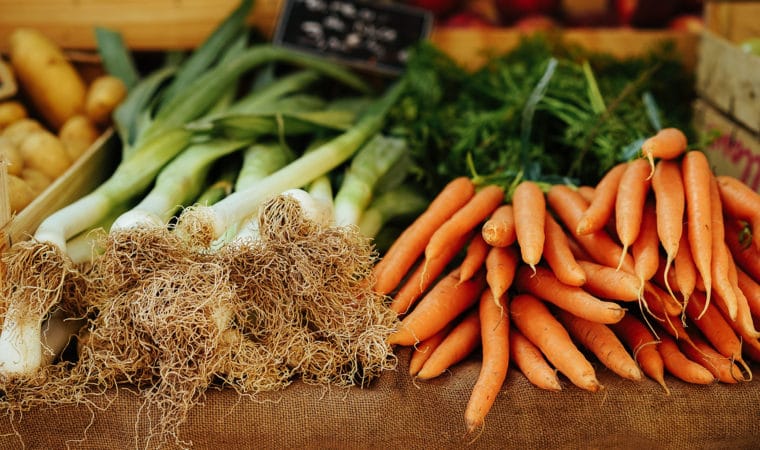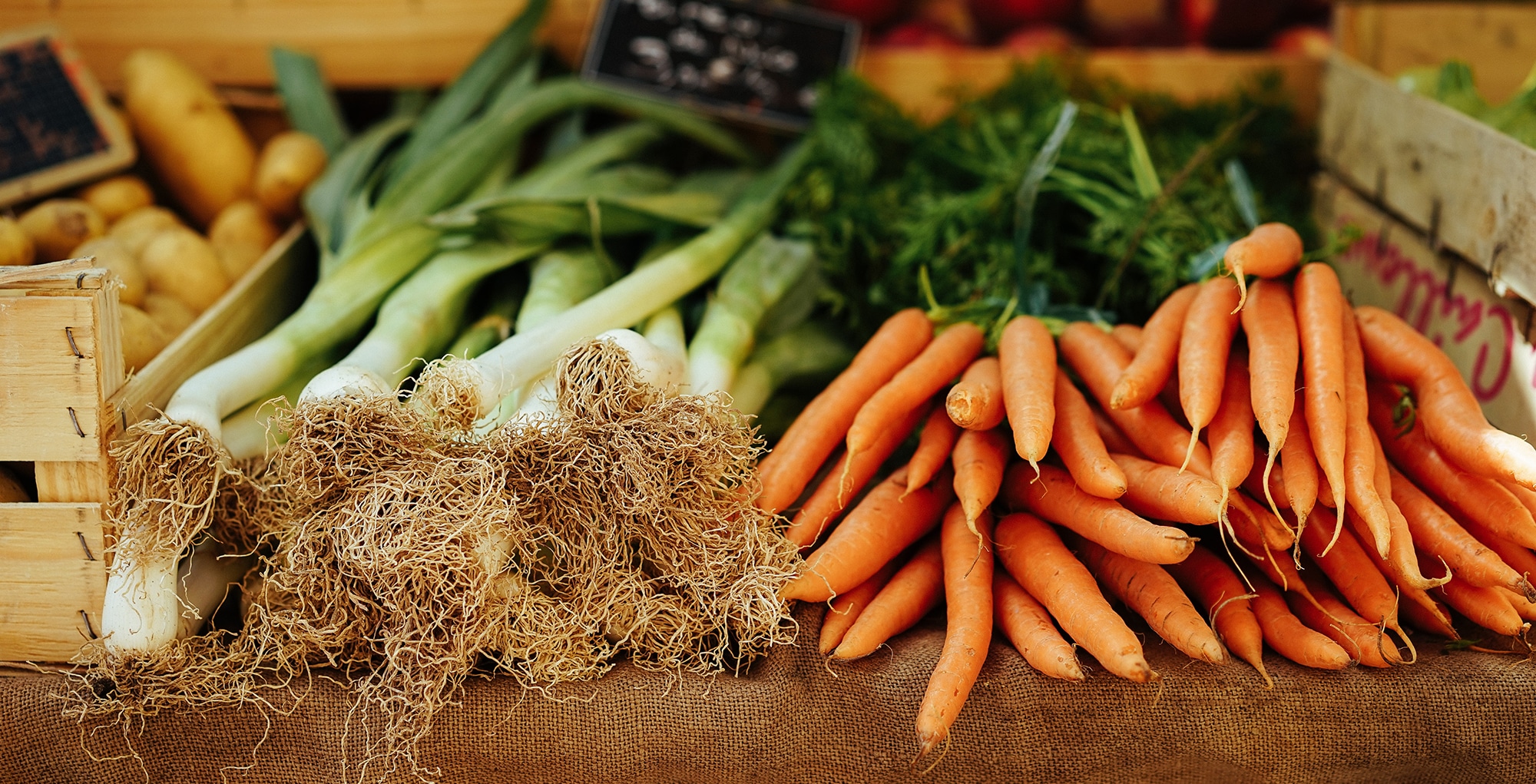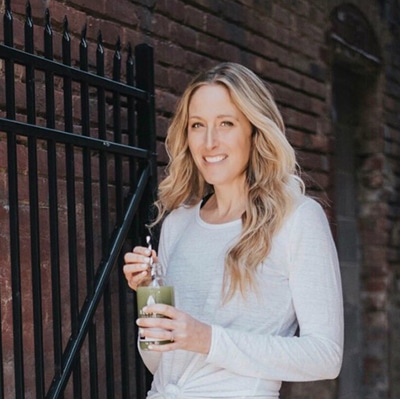Gut Health – What is it and How to Improve It?
Gut health is undoubtedly having its moment and it is not going anywhere anytime soon. One glimpse into the current wellness space and you will find an abundance of information and research on the topic. But why is it so important? In order to answer this and other gut health related questions it is important to present a quick snapshot of the gut, the microbiome that it houses and its connection to our overall health.
For years the gut was regarded entirely as a digestive organ, a means for processing food and nutrients and disposing of waste. Researchers now spend time focusing on the microbiome in the gut and its interplay with virtually every system in our bodies.
The microbiome is an entire ecosystem of microorganisms housed primarily in the large intestine or colon. Thirty-nine trillion of these microorganisms live in and on us. That is ten times the number of human cells in the body![1] The microbiome has the ability to communicate with our brain and our immune system, affect gene expression, control hunger and satiety and regulate hormones. With this in mind, it is easy to see why it is so important to keep our gut functioning optimally.
What is gut health?

Gut health collectively refers to the proper functioning of our digestive tract, the diversity of our microbiome and the absence of digestive illness or disorders. If you think of it a different way, gut disease is just that- ‘dis’–‘ease’, meaning lack of ease in the gut or digestive tract. Symptoms of poor gut health include nausea, vomiting, diarrhea, constipation, gas, bloating and stomach pain. So how do we avoid it? First let’s look at what is happening in the gut to cause these symptoms.
When our gut microbes are out of balance, i.e. the bad gut bugs outnumber the good gut bugs, we have a state of dysbiosis. Bad gut bugs are pro-inflammatory and when they crowd out the good bugs they start to damage the lining of the gut. Additionally, the tight junctions within the cell wall of the gut can start to loosen. Once this happens we have a situation called leaky gut or increased intestinal permeability.[2] And yes, it is as bad as it sounds. Leaky gut allows for undigested food particles, toxins and microbes to spill out into the bloodstream. The result? An array of symptoms ranging from mood disorders, GI disorders, skin disorders and hormonal imbalances to allergies and chronic pain.
Many factors contribute to an unhealthy gut. On the flipside, there are diet and lifestyle factors we can adopt to ensure a robust microbiome and thus a healthy gut.
Factors that disrupt gut health:

- Animal products (red meat, dairy and processed meat). These foods increase the number of pro-inflammatory bacteria in the gut. It is best to limit these foods in the diet and opt for a more plant based diet.
- Refined sugar and artificial sweeteners. Studies show that artificial sweeteners induce dysbiosis…the main culprits being sucralose, aspartame and saccharin. [3,4] Refined sugar impedes the growth of healthy gut bacteria [5]. Additionally, if you frequently consume sugar you will produce a microbiome that is trained to process and crave sugary foods. Bottom line: the bacteria in your gut can actually affect your cravings! [6] Replace refined sugar and artificial sweeteners with natural sweeteners in moderation such as maple syrup, dates and date syrup.
- Processed foods. Sure, these foods are highly palatable, but unfortunately they contain ingredients that damage the gut microbiome. They cause a lack of microbial diversity, promote pro-inflammatory microbes and crowd out gut friendly foods in the diet. Ingredients such as emulsifiers, preservatives, hydrogenated oils and additives provide no benefit to our gut health.[7]
- Overuse or misuse of antibiotics. While I do believe there is a time and place for antibiotics, they tend to be overused. Antibiotics are prescribed to kill bacteria; however, they are not selective when it comes to which bacteria they destroy. Antibiotics take out both the good and bad microbes and it can take months to years, if ever, to regain the microbial diversity that an antibiotic wipes out. Additionally, hidden sources of antibiotics exist in our environment including farmed fish, antibiotic residue on meats and in our water supply.
Dietary and lifestyle factors that improve gut health:

- Increase plant diversity in the diet. Plant diversity in the diet is by far the number one indicator of gut health. A diversity of plants equals a diversity of gut microbes. Period. Adopting a plant based diet is the easiest way to increase the diversity of plants in the diet. A plant based diet consists of fruits, vegetables, whole grains, nuts, seeds and legumes. Goal: Aim for a variety of 20+ plants per day.
- Increased fiber in the diet. When you increase the number and diversity of plants in your diet you naturally increase your intake of fiber. Fiber is classified into two forms: soluble and insoluble fiber, both of which help maintain gut health.
- Soluble fiber: Soluble dissolves in water and forms a viscous gel, which bypasses digestion in the small intestine and arrives in the large intestine where it undergoes fermentation by gut bacteria. Sources of soluble fiber include oats, barley, fruits, legumes, carrots and most root vegetables.
- Insoluble fiber: Insoluble fiber is not water soluble and forms the bulk of our stool. Insoluble fiber sources include green vegetables, avocado, skins of tree fruits, whole grains, nuts and seeds.
- Goal: Aim to have at least 3 sources of fiber in every meal or snack.
- Pre-, pro- and postbiotics. Probiotics are the living microbes that are beneficial to the gut. Prebiotics are the actual food that feed the healthy microbes living in the gut. Postbiotics are the end product of the prebiotics feeding the probiotics.
- Probiotics: Consuming fermented, probiotic foods may help increase microbial diversity and thus improve gut health.[8] Probiotic foods and drinks include sauerkraut, non-dairy yogurt or kefir, kombucha, tempeh and kimchi.
- Prebiotics: Prebiotic foods promote growth of beneficial bacteria and are found in foods high in soluble fiber (avocadoes, berries, greens, beans, flax, apples and broccoli) and resistant starch (potatoes, rice and oats).
- Postbiotics: The postbiotics formed when prebiotics feed the healthy gut microbes are called short chain fatty acids (SCFA’s). SCFA’s (butyrate, acetate and propionate) are the real MVP’s when it comes to healing the gut. SCFA’s have the ability to repair both the gut lining and restore the tight junctions in the gut thereby reversing the damaging effects of leaky gut.[9]
- Goal: Aim for one serving of fermented or probiotic-rich food and a variety of prebiotic foods per day.
- Lifestyle factors. Lifestyle factors, such as sleep, stress, exercise and time outdoors are tied to our gut health. Sleep, time outdoors and exercise, combined with a low stress environment positively impact the gut microbiome. Even mild stress can tip the microbial balance in the gut leading to dysbiosis of the microbiome.[10] Did you know that our microbiome has a natural rhythm, much like our circadian rhythm? If our circadian rhythm is disrupted it follows that the microbiome’s rhythm is disrupted leading to diminished microbial health.[11] Aim for at least 7 hours of sleep per night to keep your gut healthy. Studies also show that individuals who regularly exercise have more microbial diversity and that exercise promotes the formation of SCFA’s.[12] Even better if you can take your workout outside since spending time outdoors positively influences the microbiome. Exposure to beneficial bacteria in the soil and on flora may increase microbial diversity, and thus also improve gut health.[13]
Simple snacks for optimal gut health:
The following are balanced, nutrient dense snacks that I regularly recommend to my clients as part of a plant based, gut friendly diet.
Loaded yogurt bowl:
Forager Project Unsweetened Vanilla Bean Cashewmilk Yogurt topped with ½ cup fresh or frozen berries, 1 tablespoon flaxseed, chia seed or hemp seed (or a combination of the three), 1 tablespoon almond butter or nut butter of choice and 1 tablespoon cacao nibs.
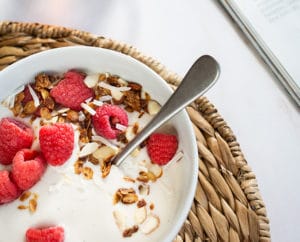
Creamy avocado toast with hemp seeds:
Mash ½ avocado with 2 tablespoons Forager Project Unsweetened Plain Cashewmilk Yogurt (Forager Project Dairy-free Sour Cream works too), a squeeze of lemon juice, salt and pepper. Top two slices of toasted sprouted wheat bread with the avocado mash. Garnish With a sprinkling of hemp seeds and red pepper flakes.
Sweet or savory potato bowl:
For the sweet version, top ½ a baked sweet potato with cinnamon, almond butter, blueberries, ¼ cup of Forager Project Cashewmilk Yogurt (Unsweetened Plain or Unsweetened Vanilla Bean) and a sprinkle of hemp seeds. For the savory version, top ½ of a baked sweet potato with black beans, salsa and the same avocado mash and Forager Project Unsweetened Plain Cashewmilk yogurt used in the toast above. Sprinkle with hemp seeds.
Fruit and yogurt smoothie:
10oz. Forager Project Unsweetened Cashewmilk or Oatmilk, 1/3 cup frozen cauliflower, ½ frozen banana, 1/3 cup frozen blueberries, 1 tablespoon flaxseed, 1 tablespoon cashew butter. Blend in a high-speed blender and enjoy.
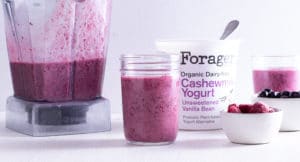
References:
- NIH HMP Working Group et al. “The NIH Human Microbiome Project.” Genome research vol. 19,12 (2009): 2317-23. doi:10.1101/gr.096651.109
- Pereira, Matthew T et al. “Effect of dietary additives on intestinal permeability in both Drosophila and a human cell co-culture.” Disease models & mechanisms vol. 11,12 dmm034520. 28 Nov. 2018, doi:10.1242/dmm.034520
- Ruiz-Ojeda, Francisco Javier et al. “Effects of Sweeteners on the Gut Microbiota: A Review of Experimental Studies and Clinical Trials.” Advances in nutrition (Bethesda, Md.) vol. 10,suppl_1 (2019): S31-S48. doi:10.1093/advances/nmy037
- Suez, Jotham et al. “Non-caloric artificial sweeteners and the microbiome: findings and challenges.” Gut microbes vol. 6,2 (2015): 149-55. doi:10.1080/19490976.2015.1017700
- Kruis, W et al. “Effect of diets low and high in refined sugars on gut transit, bile acid metabolism, and bacterial fermentation.” Gut vol. 32,4 (1991): 367-71. doi:10.1136/gut.32.4.367
- Alcock, Joe et al. “Is eating behavior manipulated by the gastrointestinal microbiota? Evolutionary pressures and potential mechanisms.” BioEssays : news and reviews in molecular, cellular and developmental biology vol. 36,10 (2014): 940-9. doi:10.1002/bies.201400071
- Zinöcker, Marit K, and Inge A Lindseth. “The Western Diet-Microbiome-Host Interaction and Its Role in Metabolic Disease.” Nutrients vol. 10,3 365. 17 Mar. 2018, doi:10.3390/nu10030365
- Singh, Rasnik K et al. “Influence of diet on the gut microbiome and implications for human health.” Journal of translational medicine vol. 15,1 73. 8 Apr. 2017, doi:10.1186/s12967-017-1175-y
- Żółkiewicz, Jakub et al. “Postbiotics-A Step Beyond Pre- and Probiotics.” Nutrients vol. 12,8 2189. 23 Jul. 2020, doi:10.3390/nu12082189
- Maltz, Ross M et al. “Social Stress Affects Colonic Inflammation, the Gut Microbiome, and Short-chain Fatty Acid Levels and Receptors.” Journal of pediatric gastroenterology and nutrition vol. 68,4 (2019): 533-540. doi:10.1097/MPG.0000000000002226
- Bishehsari, F., Voigt, R.M. & Keshavarzian, A. Circadian rhythms and the gut microbiota: from the metabolic syndrome to cancer. Nat Rev Endocrinol 16, 731–739 (2020). https://doi.org/10.1038/s41574-020-00427-4
- Chen, J., Guo, Y., Gui, Y. et al. Physical exercise, gut, gut microbiota, and atherosclerotic cardiovascular diseases. Lipids Health Dis 17, 17 (2018). https://doi.org/10.1186/s12944-017-0653-9
- Sobko, T., Liang, S., Cheng, W.H.G. et al. Impact of outdoor nature-related activities on gut microbiota, fecal serotonin, and perceived stress in preschool children: the Play&Grow randomized controlled trial. Sci Rep 10, 21993 (2020). https://doi.org/10.1038/s41598-020-78642-2
